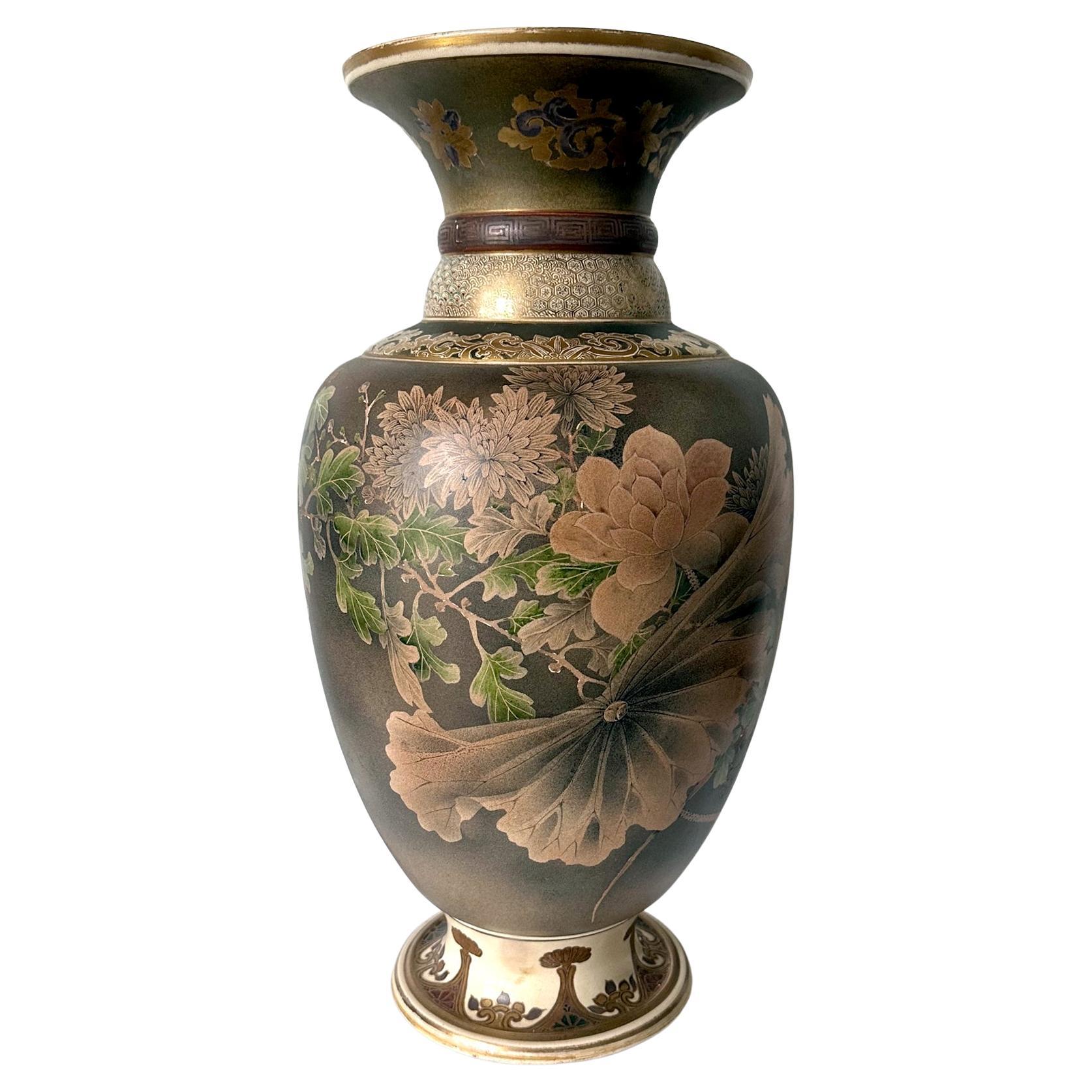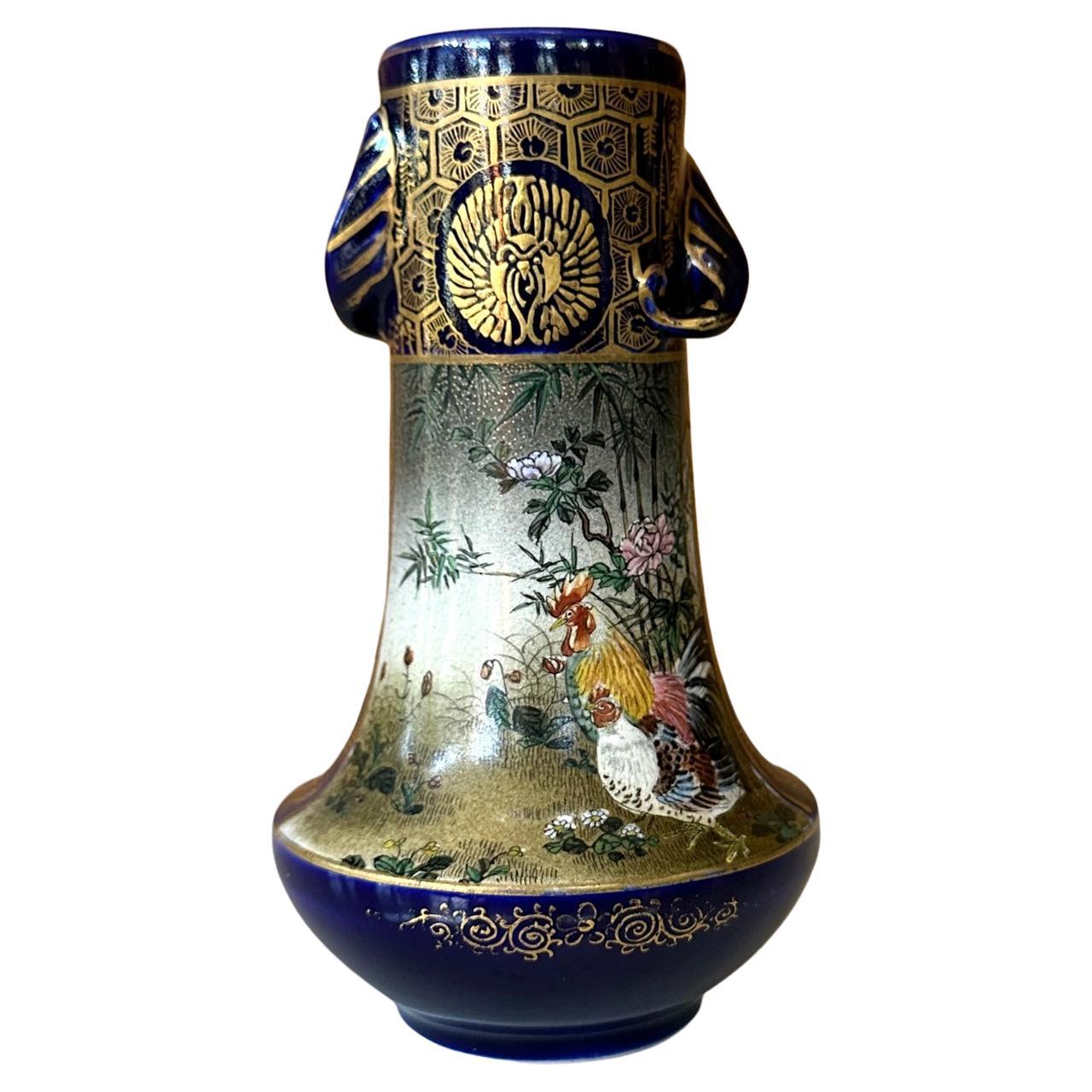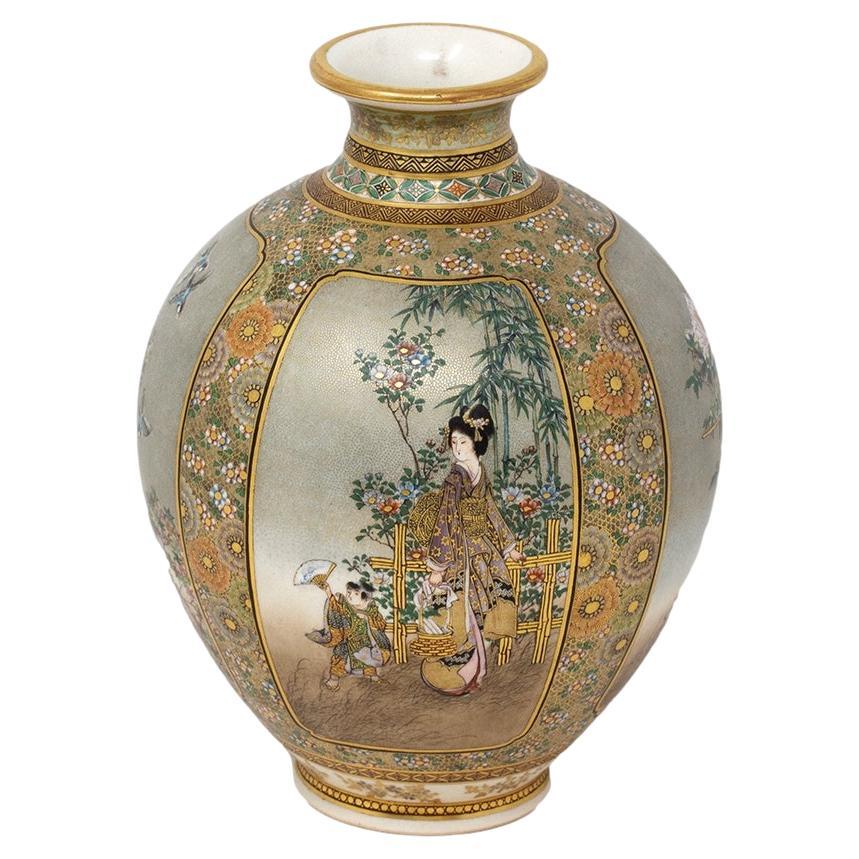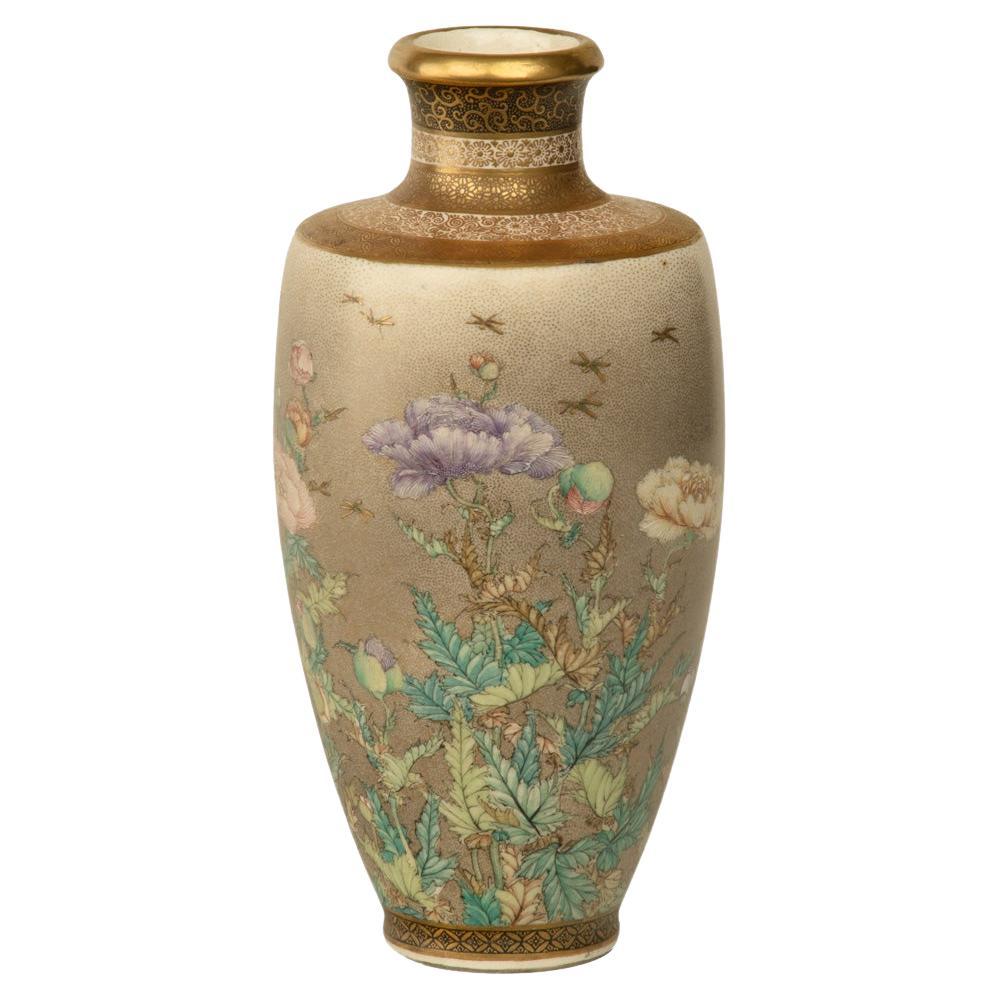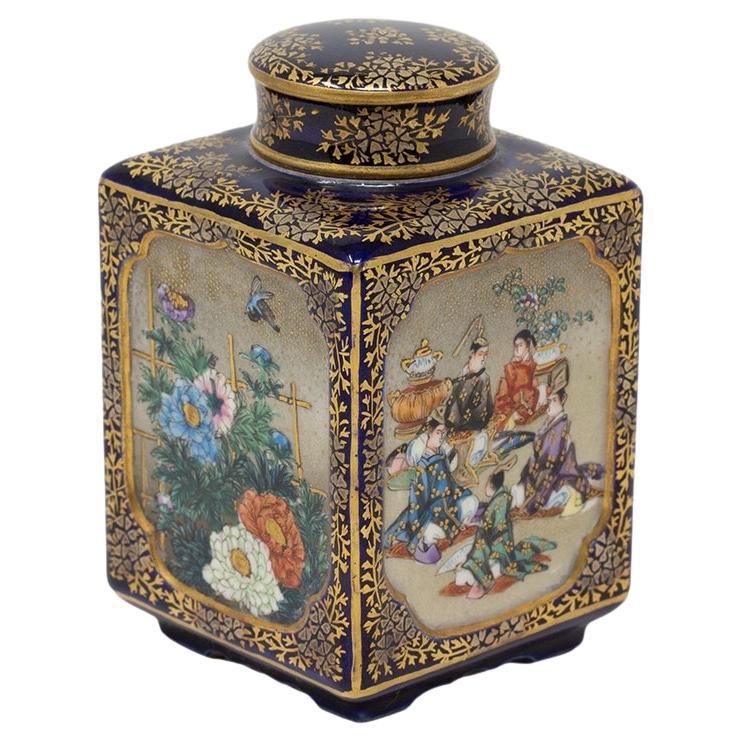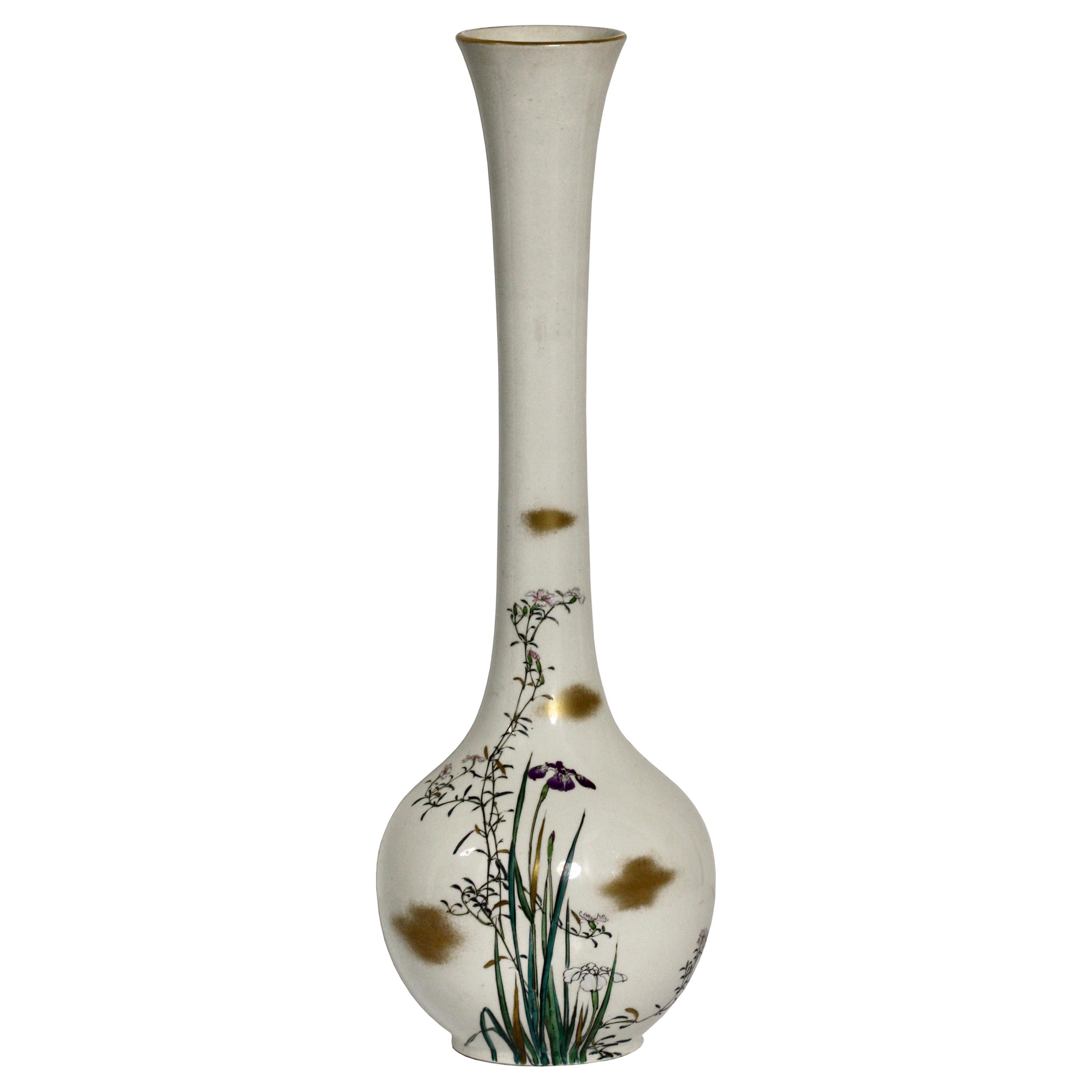Items Similar to Large Japanese Satsuma Vase by Kinkozan
Want more images or videos?
Request additional images or videos from the seller
1 of 7
Large Japanese Satsuma Vase by Kinkozan
About the Item
As part of our Japanese works of art collection we are delighted to offer this finely decorated Meiji Period (1868-1912), Satsuma vase stemming from the highly regarded Kinkozan studios in Kyoto. This large vase is beautifully decorated with opposing heart shaped panels sat within a vibrantly gilded cobalt blue body, the first panel houses a flock of small songbirds in flight beneath a sumptuously decorated hanging ikebana display, the reverse decorated with a pair of geese within a floral landscape aside a waterside setting, each panel painstakingly stippled with fine gilt highlights, the vase houses a pair of elephant head ring handles each side of the gilded main body, the underside of this beautiful vase still carries the original company label as well as a clean untouched gilt signature seal for Kinkozan of Kyoto. A perfect addition to any serious Japanese Satsuma collection.
Condition report :
Lovely condition with minimal wear.
Approximate sizes :
Height : 10" 25.5 cm
Width : 5" 12.5 cm
Depth : 4 1/2" 11.5 cm
Free worldwide delivery and a certificate of authenticity are included within the price of this item.
- Creator:Kinkozan (Artist)
- Dimensions:Height: 10 in (25.4 cm)Width: 5 in (12.7 cm)Depth: 4.5 in (11.43 cm)
- Style:Meiji (Of the Period)
- Materials and Techniques:
- Place of Origin:
- Period:
- Date of Manufacture:1900
- Condition:Wear consistent with age and use.
- Seller Location:Christchurch, GB
- Reference Number:
About the Seller
5.0
Vetted Seller
These experienced sellers undergo a comprehensive evaluation by our team of in-house experts.
Established in 2011
1stDibs seller since 2023
Typical response time: 1 hour
- ShippingRetrieving quote...Ships From: Christchurch, United Kingdom
- Return PolicyA return for this item may be initiated within 14 days of delivery.
More From This SellerView All
- Fine Japanese Satsuma Ceramic Vase by KinkozanBy KinkozanLocated in Christchurch, GBAs part of our Japanese works of art collection we are delighted to offer this finely decorated Meiji Period (1868-1912) Satsuma vase stemming from the highly regarded Kinkozan studi...Category
Antique Late 19th Century Japanese Meiji Ceramics
MaterialsCeramic
- Fine Japanese Satsuma Bowl – Matsumoto ShozanLocated in Christchurch, GBAs part of our Japanese works of art collection we are delighted to offer this extremely fine quality Meiji Period (1868-1912) Satsuma bowl, the underside artist signed by Matsumoto ...Category
Antique 19th Century Japanese Meiji Ceramics
MaterialsCeramic
- Japanese Ceramic Vase by Makuzu KozanBy Makuzu Kozan IILocated in Christchurch, GBAs part of our Japanese works of art collection we are delighted to offer this charming Meiji Period 1868-1912, ceramic baluster vase from the studios of the highly coveted Imperial ...Category
Antique 19th Century Japanese Meiji Ceramics
MaterialsCeramic
- Large Japanese Ceramic Vase by Makuzu KozanLocated in Christchurch, GBAs part of our Japanese works of art collection we are delighted to offer this tapering square form Meiji Period 1868-1912, ceramic vase from the studios of the highly coveted Imperi...Category
Antique 19th Century Japanese Ceramics
MaterialsCeramic
- Large Japanese Ceramic Charger by Fukagawa Seiji CompanyBy FukagawaLocated in Christchurch, GBs part of our Japanese works of art collection we are delighted to offer this large Meiji Period (1868-1912) ceramic charger made under the banner of the Fukagawa Seiji Gaisha, a bre...Category
Antique Late 19th Century Japanese Meiji Ceramics
MaterialsCeramic
- Large Japanese Kutani Jardiniere on Hardwood StandLocated in Christchurch, GBAs part of our Japanese works of art collection we are delighted to offer this large Meiji Period (1868-1912), Kutani Jardiniere vibrantly decorated ...Category
Antique 19th Century Japanese Meiji Ceramics
MaterialsEnamel
You May Also Like
- Large Japanese Satsuma Ceramic Vase KinkozanBy KinkozanLocated in Atlanta, GAA large Japanese ceramic vase from the end of Meiji period circa 1890-1910s by Kinkozan (1645-1927). One of the largest studio manufacturers of the export ceramics at the time based in Kyoto. In the typical style of satsuma made at the turn of 20th century, the vase is elaborately decorated with a rather unusual kinran-de (gold paint) and green enamel highlight on a mottled brown background. The painterly decoration depicts a large seasonal floral arrangement in a circular fashion. Besides the obviously superb craftsmanship, what sets this particular vase apart from many lower quality and mass-produced pieces is its tone-on-tone color pallet that is visually somber and the small and sensitive details that heralds the change of the seasons. When the viewer goes beyond the first casual glimpse of the blossom and foliage, one would notice that on the edges of certain leaves as well as along the stalks, there accumulates a very thin layer of the white dust that represents the frost. The flower in bloom are chrysanthemums. Despite of being splendid, they are the messengers of the autumn. The large lotus leaf was subtly rendered in a bended and slightly withered manner, just past its prime. Although the lotus is still in bloom, the prominent seed pod indicates it may be the last for the season. The sentimental capture of the change of the seasons is not unusual in Japanese art. This vase poetically represents such a subtle transition from summer to fall, perhaps depicting the very first frost. The neck of the vase is also slightly unusual with two rolled rings...Category
Early 20th Century Japanese Meiji Ceramics
MaterialsCeramic
- Fine Japanese Ceramic Satsuma Vase by KinkozanBy KinkozanLocated in Atlanta, GAA miniature Japanese ceramic vase from the end of Meiji period circa 1880s- 1910s by Kinkozan (1645-1927). One of the largest studio manufacturers of the export ceramics at the time ...Category
Early 20th Century Japanese Meiji Ceramics
MaterialsCeramic
- Japanese Meiji Period Satsuma Vase by KinkozanBy KinkozanLocated in Newark, EnglandThe vase is potted in globular form with a tightly pinched neck and rolled top rim beautifully decorated with four highly detailed individual panelled scenes. The first a Geisha bari...Category
Antique Late 19th Century Japanese Meiji Ceramics
MaterialsCeramic, Earthenware, Pottery
- Japanese Satsuma Natsume KinkozanBy KinkozanLocated in Newark, EnglandCobalt Blue Natsume From our Japanese collection, we are delighted to offer this Japanese Satsuma Natsume by Kinkozan. The Natsume of elongated rectangular form with four recessed panels each bordered by a gilt foliage decoration. The Natsume raised upon a square base with a scalloped centre. The top of the Satsuma finished with the original lid with matching gilt foliage decoration. The panels of the Satsuma decorated with multiple figures in various pursuits framed within a shaped recesses. The base of the Satsuma is signed with the Kinkozan mark. The Natsume dates to the Meiji Period (1868-1912) circa 1890. Natsume is a Chaki 茶器 (tea implement) used in a Japanese Tea Ceremony and is a term for a Japanese Tea Caddy...Category
Antique Late 19th Century Japanese Meiji Ceramics
MaterialsEnamel
- Kinkozan, Japanese Satsuma Vase, Meiji PeriodBy KinkozanLocated in West Palm Beach, FLKinkozan, Japanese Satsuma vase, Meiji Period (1868-1912) Of baluster form with an elongated neck decorated in polychrome enamels and gilt on a clear crackle glaze in an Art-Nouvea...Category
20th Century Ceramics
MaterialsCeramic
- Japanese Meiji Period Satsuma Bowl KinkozanBy KinkozanLocated in Newark, EnglandFrom our Japanese collection, we are delighted to offer this Japanese Meiji period Satsuma Bowl by Kinkozan. The earthenware bowl with pinched rim extensively decorated on both the exterior and interior. The bowl with a cobalt blue base glaze decorated to the borders with gilt shippo-tsunagi (linked-cash) with scattered medallion roundells. Around the exterior two elongated scenes are featured, one with boys playing games in a courtyard with the other featuring seated scholars in full dress both with raised enamel decoration. The interior features a central scene with Samurai warriors in training fully armoured with swords in a courtyard with landscapes scenes to the background. The central scene bordered by further stylised shippo-tsunagi type decoration with a greek key rim border. The bowl signed to the base Kinkozan dating to the Meiji Period (1868-1912) circa 1900. Shippo-Tsunagi (linked-cash) or seven treasures, is a traditional Japanese geometric pattern that combines four ellipses in a circle. These ellipses repeat outward to then create more circles, symbolising eternal peace and happiness. Kinkozan the Kinkozan family have been associated with pottery dating back to 1645. They went on to become the largest producer of Satsuma ware by one individual company, from the end of the 19th century until 1927 after which the factory closed. By the 1850s Kobayashi Sobei (1824-84), Kinkozan Sobei...Category
Antique Early 1900s Japanese Meiji Ceramics
MaterialsCeramic, Earthenware, Pottery, Faux Leather
Recently Viewed
View AllMore Ways To Browse
Celadon Blue And White
Celadon Bird Motif
Imperial Nippon Hand Painted Vase
Antique Chinese Cloisonne Sold
Chinese Porcelain Blanc De Chine Goddess Guanyin
Antique Chinese Ding
Arita Porcelain Box
Large White Italian Porcelain Asian Sculpture
Japanese Sake Tokkuri
Antique Japanese Porcelain Okimono
Blanc De Chine Quan Yin
Blanc De Chine Quan
Chinese Porcelain Censor
Hatcher Cargo Porcelain
Dragon Pheonix
Kenzan Pottery
Majapahit Terracotta
Momoyama Chawan
